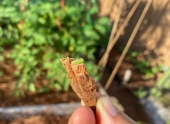




Welcome to the serfdom.
 9
9




 2
2




Welcome to the serfdom.
 9
9




Jeff Steez wrote:Well it's gotten worse as expected, it's on many of the leaves. Not terrible but...
The plants are all done with SFG. So 1 tomato per SF. They're definitely a bit cramped but SFG always looks cramped, my first time trying it. Plenty of air flow, should not be an issue, the leaves are always moving around.
Never really been a tomato person, I thought I got lucky but apparently not. The South Florida humidity is no joke. I might have messed it all up spraying them with something that was mildly infected, sometimes I crush super hot peppers and put them in the mix.
Now that I look at my other tomato seedlings, they too have some spotting. I am 90% certain this occurred from a recent bi-weekly soap spraying. I hope they can recover...
 9
9




 4
4




Invasive plants are Earth's way of insisting we notice her medicines. Stephen Herrod Buhner
Everyone learns what works by learning what doesn't work. Stephen Herrod Buhner
 2
2




Welcome to the serfdom.
 9
9




 6
6




“The most important decision we make is whether we believe we live in a friendly or hostile universe.”― Albert Einstein
 7
7




In modern times the only right way forward is to come back to nature.
 6
6




This is all just my opinion based on a flawed memory

 3
3




Welcome to the serfdom.
 11
11




“We can complain because rose bushes have thorns, or rejoice because thorn bushes have roses.” — Abraham Lincoln
 8
8




This is all just my opinion based on a flawed memory









 5
5




 5
5




 1
1




 4
4








 1
1




Invasive plants are Earth's way of insisting we notice her medicines. Stephen Herrod Buhner
Everyone learns what works by learning what doesn't work. Stephen Herrod Buhner
 3
3




Welcome to the serfdom.
 1
1




This is all just my opinion based on a flawed memory

 1
1




“We can complain because rose bushes have thorns, or rejoice because thorn bushes have roses.” — Abraham Lincoln
 2
2




Welcome to the serfdom.

|
Oh, sure, you could do that. Or you could eat some pie. While reading this tiny ad:
Play Your Way to a Sustainable Lifestyle: Uncover Permaculture Principles with Each Card
https://gardener-gift.com/
|






